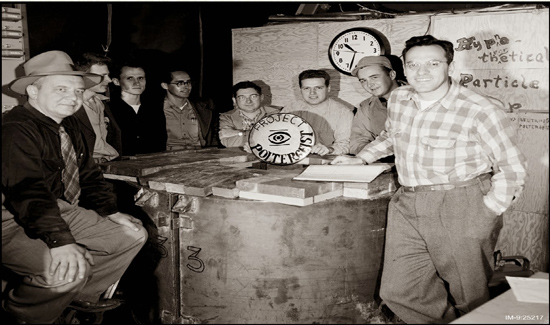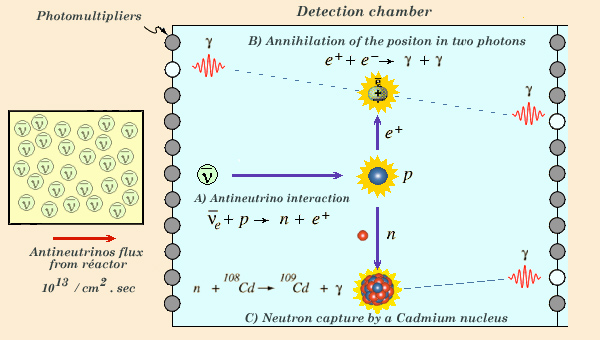The Reines and Cowan experiment
When in 1956, two Américans physicists Cowan et Reines, proved that the neutrino was a real particle, its existence was admitted, but it was considered « undetectable ».

Reines and Cowan started their neutrino detection experiment with a reactor at Hanford in Washington State. Then they moved to a new, more powerful reactor at Savannah River in South Carolina. In this 1953 photograph of the team at Hanford, Cowan appears at the far left and Reines at the far right . This pioneering experience, they was called the Poltergeist project, definitely proved the existence of the neutrino and opened the way for neutrino physics.
© Musée Curie
It was in the mid 1950s that Clyde Cowan and Frederick Reines set up their experiment to prove the existence of neutrinos. That was the time also when the first nuclear reactors for civilian use were put into operation. Cowan and Reines had the idea to take advantage of the intense flux of neutrinos they generated, fluxes ranging from 1000 to 10,000 billion neutrinos per second and square centimetre, much more intense than those expected from radioactive sources.
Beta decay of fission products in reactors generate neutrinos, which are actually antineutrinos. Only a tiny fraction of these antineutrinos have the opportunity to interact with protons through the so-called and simple inverse beta reaction : The proton become a neutron and the antineutrini a positon.
The interaction produces a neutron plus a positron.
© IN2P3
The positons, which are particles of antimatter, quickly found electrons with which they annihilate. They vanish in a very characteristic manner through the emission of two 511 keV annihilation energetic gamma photons emitted back to back. But Cowan and Reines realized that this signature was not enough to prove that the positron was due to a antineutrino interaction. They looked for the presence of the neutron, that accompanies the positron, to confirm the reaction.
They added cadmium chloride in a water tank of 200 liters, that acts as a target and a detector as well. Cadmium is a efficient neutron absorber used in reactor control rods. By absorbing a neutron, cadmium-108 turns into an excited cadmium-109 nucleus, which emits a characteristic desexcitation gamma ray.
For gamma detection, Reines and Cowan introduced in the water volume organic liquid scintillators that had just been discovered. In response to gamma rays, these scintillators produce flashes of light that were amplified and detected by photomultipliers placed on both sides of the tank.

The Reines and Cowan detector, at Savannah River, was set at 11 m from the reactor and 12 m underground (for protection from cosmic rays). It consisted of two compartments containing a total of 200 litters of water with 40 kg of dissolved cadmium chloride, and organic liquid scintillators. The two compartments were sandwiched by three layers of photomultipliers. Despite the abundant flow of antineutrinos, the interaction of an antineutrino with a proton of water is an extremely rare event that generates a positron and a neutron. The device is designed to simultaneously detect three photons gamma signatures of these events: two from the positron annihilation photons and one following the neutron capture by a cadmium nucleus.
© IN2P3
The experimental set-up was designed in such a way that the third detected gamma should be detected less than 5 millionth of a second after the two gamma coming from the positron annihilation. The detection of three gamma within such a short time interval was an unmistakable signature of a neutrino interaction. Reines and Cowan accumulated data during several months, at an average rate of three neutrinos events per hour.
They checked that these events disappear when the reactor was stopped. Finally, they measured for this « beta inverse reaction » a rate compatible with the theoretical predictions made at the time by Bethe and Peirls.